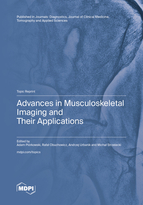Topic Menu
► Topic MenuTopic Editors



Advances in Musculoskeletal Imaging and Their Applications

A printed edition is available here.
Topic Information
Dear Colleagues,
Radiographic acquisition techniques have undergone tremendous improvements since their invention. Image resolution has greatly increased and the reduction in the dose of X-ray radiation required for its creation has been achieved. The increased amount of imaging data does not necessarily mean that more medical information is accessible to the reader. Some (but often important) information is hidden from the radiologist. This is especially true for radiographic techniques.
The purpose of advanced image-analysis systems is to extract occulted data to improve the objectivity of diagnosis for a given case. The treatment of clinical problems with information obtained using advanced image analyses has increased. In musculoskeletal radiology, proven associations exist between bone scan analyses, patient health and metabolic status. Moreover, the processes of bone maturation, bone healing, bone demineralization and deformation due to overuse can be extensively analyzed with the use of CR, CT and MRI. Advanced methods significantly improve differentiation and hence the diagnostic process of medication for different lesions including neoplasms of the bone.
Papers investigating the application of both classical image processing and artificial intelligence (AI) methods in the analysis and extraction of diagnostically useful data from medical images are welcomed in this Special Issue. Such methods assist in the investigation of the shape and geometry of, for example, bone tissue or its fragments. Other AI approaches allow for the automatic detection and segmentation of tissues or organs and the assessment of their pathologies. For this purpose, the achievements of radiomics are particularly useful, including image-texture analyses. Various machine learning methods are also useful for exploring medical imaging data and are widely used in medical diagnostic support systems. Deep learning algorithms play a particularly important role in this respect. Recently, dynamic developments have been achieved in the field of deep learning algorithms, and their effectiveness has been confirmed in numerous applications of medical image analyses of various modalities.
Prof. Dr. Adam Piórkowski
Prof. Dr. Rafał Obuchowicz
Prof. Dr. Andrzej Urbanik
Prof. Dr. Michał Strzelecki
Topic Editors
Keywords
- bone imaging
- musculoskeletal imaging
- image processing
- image analysis
- segmentation
- textural analysis
- machine learning
Participating Journals
| Journal Name | Impact Factor | CiteScore | Launched Year | First Decision (median) | APC |
|---|---|---|---|---|---|

Diagnostics
|
3.6 | 3.6 | 2011 | 20.7 Days | CHF 2600 |

Journal of Clinical Medicine
|
3.9 | 5.4 | 2012 | 17.9 Days | CHF 2600 |

Tomography
|
1.9 | 2.3 | 2015 | 24.5 Days | CHF 2400 |

Applied Sciences
|
2.7 | 4.5 | 2011 | 16.9 Days | CHF 2400 |

Radiation
|
- | - | 2021 | 24.5 Days | CHF 1000 |

MDPI Topics is cooperating with Preprints.org and has built a direct connection between MDPI journals and Preprints.org. Authors are encouraged to enjoy the benefits by posting a preprint at Preprints.org prior to publication:
- Immediately share your ideas ahead of publication and establish your research priority;
- Protect your idea from being stolen with this time-stamped preprint article;
- Enhance the exposure and impact of your research;
- Receive feedback from your peers in advance;
- Have it indexed in Web of Science (Preprint Citation Index), Google Scholar, Crossref, SHARE, PrePubMed, Scilit and Europe PMC.


